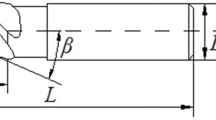Abstract
Metal cutting (or machining) is one important aspect of the manufacturing system. Selecting optimal cutting conditions for machining is then a crucial process planning task for manufacturing. Traditionally, solving such machining problems was only focused on economic objectives such as maximizing profit or minimizing production time requirement. In the recent decade, however, minimizing energy consumption in manufacturing processes has attracted increased attention due to increasing energy costs and concern with greenhouse gas emissions. Energy loss could be avoided by carefully selecting cutting parameters. This paper develops a multi-objective mathematical model to minimize unit production costs along with energy consumption for face milling operations. In addition, an evolutionary strategy (ES)-based optimization approach is used to identify optimal cutting conditions for the proposed model.
Similar content being viewed by others
References
Gutowski T, Murphy C, Allen D, Bauer D, Bras B, Piwonka T, Sheng P, Sutherland J, Thurston D, Wolff E (2005) Environmentally benign manufacturing: observations from Japan, Europe, and the United States. J Clean Prod 13(1):1–17. https://doi.org/10.1016/j.jclepro.2003.10.004
Bunse K, Vodicka M, Schönsleben P, Brülhart M, Ernst FO (2011) Integrating energy efficiency performance in production management—gap analysis between industrial needs and scientific literature. J Clean Prod 19(6–7):667–679. https://doi.org/10.1016/j.jclepro.2010.11.011
Gutowski T, Dahmus J, Thirez A (2006) Electrical energy requirements for manufacturing processes. The 13th CIRP International Conference of Life Cycle Engineering 31:623–638 Lueven, May31–June 2
Mukherjee I, Ray PK (2006) A review of optimization techniques in metal cutting processes. Comput Ind Eng 50(1–2):15–34. https://doi.org/10.1016/j.cie.2005.10.001
Shunmugam MS, Bhaskara Reddy SV, Narendran TT (2000) Selection of optimal conditions in multi-pass face-milling using a genetic algorithm. Int J Mach Tools Manuf 40(3):401–414. https://doi.org/10.1016/S0890-6955(99)00063-2
An L, Chen M (2003) On optimization of machining parameters. The 4th International Conference on Control and Automation, pp.839–843, Montreal, Canada, June 10–12, 2003. doi: https://doi.org/10.1109/ICCA.2003.1595141
Conceição António CA, Castro CF, Davim JP (2009) Optimisation of multi-pass cutting parameters in face-milling based on genetic search. Int J Adv Manuf 44(11):1106–1115. https://doi.org/10.1007/s00170-009-1933-y
Zarei O, Fesanghary M, Farshi B, Jalili Saffar R, Razfar MR (2009) Optimization of multi-pass face-milling via harmony search algorithm. J Mater Process Technol 209(5):2386–2392. https://doi.org/10.1016/j.jmatprotec.2008.05.029
Yang WA, Guo Y, Liao W (2011) Multi-objective optimization of multi-pass face milling using particle swarm intelligence. Int J Adv Manuf Technol 56(5):429–443. https://doi.org/10.1007/s00170-011-3187-8
Zein A (2012) Transition towards energy efficiency machine tools. Springer Science & Business Media
Diaz N, Redelsheimer E, Dornfeld D (2011) Energy consumption characterization and reduction strategies for milling machine tool use. Glocalized solutions for sustainability in manufacturing. Springer, Berlin Heidelberg, pp 263–267. https://doi.org/10.1007/978-3-642-19692-8_46
Mori M, Fujishima M, Inamasu Y, Oda Y (2011) A study on energy efficiency improvement for machine tools. CIRP Ann Manuf Technol 60(1):145–148. https://doi.org/10.1016/j.cirp.2011.03.099
Kianinejad K, Uhlmann E, Peukert B (2015) Investigation into energy efficiency of outdated cutting machine tools and identification of improvement potentials to promote sustainability. Procedia CIRP 26:533–538. https://doi.org/10.1016/j.procir.2014.07.083
Li W, Kara S (2011) An empirical model for predicting energy consumption of manufacturing processes: a case of turning process. Proc IMechE, Part B: J Eng Manuf 225(9):1636–1646
Kara S, Li W (2011) Unit process energy consumption models for material removal processes. CIRP Ann Manuf Technol 60(1):37–40. https://doi.org/10.1016/j.cirp.2011.03.018
Li W, Winter M, Kara S, Herrmann C (2012) Eco-efficiency of manufacturing processes: a grinding case. CIRP Ann Manuf Technol 61(1):59–62. https://doi.org/10.1016/j.cirp.2012.03.029
Li L, Yan J, Xing Z (2013) Energy requirements evaluation of milling machines based on thermal equilibrium and empirical modeling. J Clean Prod 52:113–121. https://doi.org/10.1016/j.jclepro.2013.02.039
Yoon HS, Kim ES, Kim MS, Lee JY, Lee GB, Ahn SH (2015) Towards greener machine tools—a review on energy saving strategies and technologies. Renew Sust Energ Rev 48:870–891. https://doi.org/10.1016/j.rser.2015.03.100
Isakov E (2003) Engineering formulas for metalcutting, Industrial Press, Inc.
Bäck T (1996) Evolutionary algorithms in theory and practice. Oxford University Press, New York
Wang YC, Chiu YC, Hung YP (2011) Optimization of multi-task turning operations under minimal tool waste consideration. Robot Comput Integr Manuf 27(4):674–680. https://doi.org/10.1016/j.rcim.2010.12.003
Franco G, Betti R, Lus H (2004) Identification of structural systems using an evolutionary strategy. J Eng Mech 130(10):1125–1139. https://doi.org/10.1061/(ASCE)0733-9399(2004)130:10(1125)
Bäck T, Schwefel HP (1993) An overview of evolutionary algorithms for parameter optimization. Evol Comput 1(1):1–23. https://doi.org/10.1162/evco.1993.1.1.1
Funding
This study was supported by the National Science Council of Taiwan under contract no. MOST 104-2221-E-035 -031 -MY3.
Author information
Authors and Affiliations
Corresponding author
Rights and permissions
About this article
Cite this article
Wang, YC., Kim, DW., Katayama, H. et al. Optimization of machining economics and energy consumption in face milling operations. Int J Adv Manuf Technol 99, 2093–2100 (2018). https://doi.org/10.1007/s00170-018-1848-6
Received:
Accepted:
Published:
Issue Date:
DOI: https://doi.org/10.1007/s00170-018-1848-6




